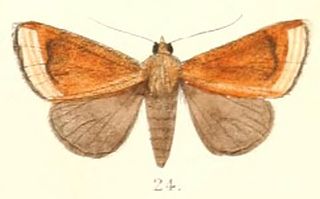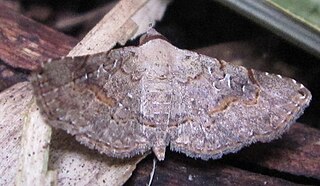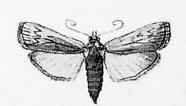Padenia is a genus of moths in the subfamily Arctiinae described by Frederic Moore in 1882.
Viettesia is a genus of moths in the subfamily Arctiinae from Madagascar. The genus was erected by Hervé de Toulgoët in 1959.

Cadarena is a monotypic moth genus of the family Crambidae erected by Frederic Moore in 1886. Its only species, Cadarena pudoraria, was first described by Jacob Hübner in 1825. It occurs throughout tropical and subtropical Africa and in India.

Talanga is a genus of moths of the family Crambidae described by Frederic Moore in 1885.

Ugia is a genus of moths in the family Erebidae erected by Francis Walker in 1858.

Catephia is a genus of moths of the family Erebidae. Most species of this genus are found in Africa.

Iambia is a genus of moths of the family Noctuidae. The genus was erected by Francis Walker in 1863.

Egnasia is a genus of moths of the family Erebidae. The genus was first described by Francis Walker in 1859.
Hiccoda is a genus of moths of the family Erebidae. The genus was erected by Frederic Moore in 1882.

Nikara is a genus of moths of the family Noctuidae described by Frederic Moore in 1882.

Rhesala is a genus of moths of the family Erebidae. The genus was erected by Francis Walker in 1858.

Colias erate, commonly known as the eastern pale clouded yellow, is a species of butterfly in the family Pieridae. It is found from south-eastern Europe, through Turkey over central Asia up to Japan and Taiwan. To the south, its range stretches to Somalia and Ethiopia. The species was first described by Eugenius Johann Christoph Esper in 1805.

Lepidoptera Indica was a 10 volume work on the butterflies of the Indian region that was begun in 1890 and completed in 1913. It was published by Lovell Reeve and Co. of London. It has been considered the magnum opus of its author, Frederic Moore, assistant curator at the museum of the East India Company. Frederic Moore described a number of new species through this publication. Moore was a splitter, known for careless creation of synonyms, sometimes placing the same species in more than one genus.

Hypsipyla robusta, the cedar tip moth, is a species of snout moth in the genus Hypsipyla. It was described by Frederic Moore in 1886. It is found from Africa, throughout Asia to Australia. Several undescribed species or subspecies might be involved.

Attonda adspersa is a moth of the family Erebidae first described by Rudolf Felder and Alois Friedrich Rogenhofer in 1874. It is known from the Democratic Republic of the Congo, Kenya, Madagascar, India, Sulawesi, Singapore, Borneo, Sumatra, Java, Bali, New Guinea and the Solomons.

Gazalina transversa is a moth of the family Notodontidae first described by Frederic Moore in 1879. It is found in Sikkim in India and in China.
Iambia thwaitesii is a moth of the family Noctuidae first described by Frederic Moore in 1885.

Ugia transversa is a species of moth in the family Erebidae first described by Frederic Moore in 1882. It is found from the north-eastern Himalayas to southern China.












